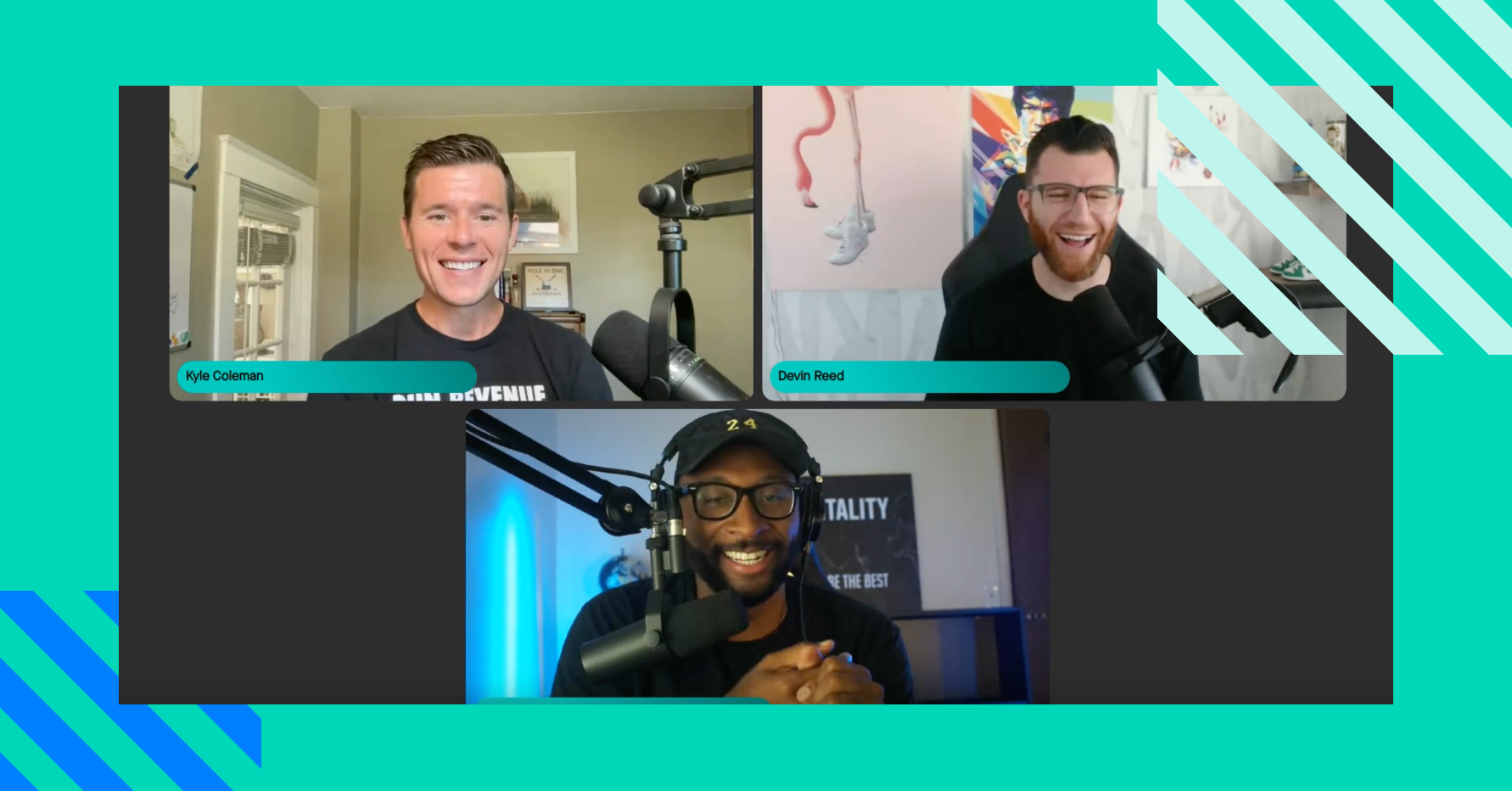What happens when three powerhouse sales and marketing pros are each given a microphone to discuss improving prospect outreach?
You get four power plays that will break through the (inbox) noise.
Our very own Kyle Coleman (CMO) and Devin Reed (Head of Content) sat down with Morgan J Ingram, founder of Ascension Media Productions, to talk about why most prospecting tactics fail and, of course, how to flip the script to close more deals using four proven power plays.
First, here's why most prospecting tactics fail
Kyle kicked off the conversation by being quite blunt:
Most prospecting tactics fail because "people don't want to do hard things. People expect some shortcuts, some easy buttons they can press, and some silver bullets that will fill their funnel. It's just not how it works. To be successful, you have to do the hard work. You have to do the things that other people aren't able or willing to do to break through the noise and to stand out."
Morgan leaned into a cooking analogy: "Everybody wants the food, but they're unwilling to use the recipes. They tend to be order-takers. They just want the food ... the opportunities ... send 'em my way! That leads to (as Kyle said) not being willing to do the hard work. However, if you learn how to leverage and use these recipes to cook your own meals, you're going to be more successful. Every person that I've coached, mentored, or trained—the most successful people are the people who knew how to build their own pipeline and close it."
More pipeline = more leverage.
Good news: So many people are creating content—blogs, podcasts, shows—that you have an excellent opportunity to learn.
Kyle believes there is a gap between reading information and taking action on that information. "Don't just be a passive recipient. If you put these things into practice, I promise that you will have a bigger commission check."
Devin still (unfortunately) encounters a lot of generic prospecting because of too much focus on persona, not enough on the person. The more generic that persona gets, the more generic your outreach gets.
However, the more specific you can be when talking about the pain, the more specific you can be when talking about the solution or, even better, the desired outcome.
So what do these three all-stars recommend? Implementing one—or all three—power plays.
Kyle's Power Play: Write unignorable sales emails leveraging basis research and ChatGPT
Which emails are unignorable? For Kyle, it's an email from Clari CEO, Andy Bryne.
Here is the process Kyle suggests:
TL;DR: Find out what your buyers' CEO is talking about or what their priorities are and frame your email outreach to be about their CEO. Connecting your value prop to that message makes it an unignorable sales message.
Step 1
Google the CEO's name with "interview," "press release," or something similar. If it's audio, there is likely a transcript. Grab it.
Step 2
Pull the video/audio transcript into ChatGPT and write this prompt: "Please provide the top 3 insights from this" (and paste the transcript).
Step 3
Use ChatGPT again with this prompt: "Please write a 50-word email to a CMO using these 3 insights." Note: This email will not be perfect but will be an excellent starting point.
PROTIP: Don’t be afraid to use Chat GPT to shortcut a lot of the menial work and solve the kind of “blank page problem” many marketers or sellers have.
Step 4
Send this email to the direct reports that roll up to the CEO.
One thing to keep in mind: The subject line is critical. Be sure it's tied to the research you did about the CEO. Don't hesitate to use the name of the CEO!
Devin's Power Play: Make an offer, not an ask
Most prospecting emails end by asking for something.
"To break through the noise, do something different than most sellers,” says Devin.
Devin suggests making them an offer instead of asking for time for a meeting. For example, ask if they'd like to be on your podcast.
When—not if—they say yes ...
Record the podcast. Then, take specific clips from the episode and send them back to the guest using the following: "Thanks for being on the podcast. I heard that you're focused on XYZ. That's actually what we do. Would you be interested in a call?"
Note: If your company doesn't have a podcast, offer a free ... something. Email deliverability company? Ask if they want a free assessment. SEO expert? Review their site.
Morgan's Power Play: Add video to your emails
Before you brush off this idea, know that Morgan has sent 63 video emails using the approach shared below with the following results:
- 69-70% open rate
- 20% reply rate
Pretty. Darn. Good.
Morgan, who is clearly a Golden State Warriors fan, says that that play "will make you feel like Steph Curry. You will hit shot after shot after shot."
Sports analogies aside, this is how Morgan runs it.
First, use the 10-30-10 video formula.
- First 10 seconds: Reason for the video. For example, you saw something on their website (think Kyle or Devin's plays).
- Middle 30 seconds: Your value prop. Super simple. Grab it from your cold calling. You just need to say it out loud.
- Last 10 seconds: Close with an "interest" call to action.
Morgan: "No editing. No crazy lights. Nothing insane. Just be you, and you'll be fine, I promise. Add the human element."
Once you have your 60-second video, here's how to set up the email:
Subject line
[Their first name] + [Your name]: + "quick video"
Body copy
"I made you a video that could help with X." If you have more personalization, you can add that.
Be sure to add: "This video is less than 60 seconds. I know putting a video in an email might be weird. However, sending something different to stand out in your inbox is the goal."
Then use the Chris Voss close: "Would you be opposed to clicking the video to see what I have to say?"
And now, the final action is sending the video email and reviewing the results:
Step 1
Send out a video email and review the view metrics.
Step 2
All those who viewed 3x or more get moved to a "video only" cadence.
Note: Every single video is unique to the person. This is not a scalable play. It must be one-to-one.
Kyle's (Bonus) Power Play: Walk the halls.
It's metaphor time.
Imagine the old days when people worked in person—on-site sales calls complete with a badge to get into somebody's headquarters. Imagine that you have a badge; you're walking around, walking the halls, shaking hands, asking questions, and learning about the business.
In a virtual world with no badge and no office halls to walk around, "you must put in the effort," says Kyle. "Instead of only focusing on the only person who can actually sign the deal (CFO), 'walk the halls' means speaking to 10 to 20 people (on LinkedIn) who are 'below the (power) line.'"
Your message is: "I'm about to reach out to your CRO, and I don't want to fall on my face. Can we chat for 5 min?"
When you reach out to the CRO, you can say, "I just talked to Jason, Maya, and Lynn, and they told me how you're using spreadsheets to manually forecast—inefficient and ineffective. We can show you a better way."
Now it's your turn to use one (or all 4) of these prospecting power plays
You've read this far. You have four power plays you can start using today to prospect to new buyers.
You've "invested in your own learning," as Kyle says. Now go put one of these plays into action today.
As Kyle says: "Don't just be a passive recipient. This is not just a reality show on Netflix that you're binging to kill some time. This is to improve your career."
Finally, with the integration of Groove, Clari now offers a complete Revenue Platform.
Ready to begin standardizing and scaling these plays to run on Groove? Schedule a demo of Clari + Groove here.
Your turn.


